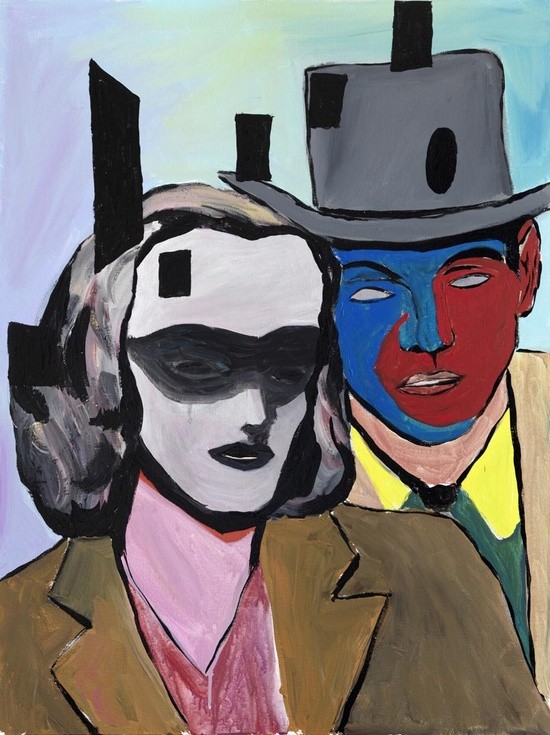Medley Tour London by Andy Hope 1930
19 Apr - 26 May 2012
MEDLEY TOUR LONDON BY ANDY HOPE 1930
19 April – 26 May, 2012
Berlin-based artist Andy Hope 1930 has developed a far-reaching and diverse iconography combining the worlds of comic books, science fiction and mythology with history, pop culture and literature. For his exhibition at Hauser & Wirth, ‘Medley Tour London by Andy Hope 1930’, Hope will present the ‘X-Medleys’: a new series of paintings that weaves together elements from his unique pictorial language. Displayed alongside new and re-invented installations, this body of work represents a significant progression in Hope’s practice, which develops with each stop on the artist’s ‘Medley Tour’.
A ‘medley’ is commonly defined as a piece of music consisting of several harmonically adjusted melodies taken from a musician’s entire repertoire. Likewise for the ‘X-Medleys’, Hope re-visits different iconographic elements which have played a major role in his oeuvre, as well as works from modernism and contemporary art. He then formulates these elements anew through a process of revision, erasure and dislocation, providing his audience with a fresh perspective with which to approach his new paintings, earlier works and his appropriated references. For example, Hope’s ‘X-Medley 2’ was inspired by Francis Picabia’s painting of a young couple sitting underneath a cherry blossom tree. Hope adopts this basic composition and superimposes his own symbols: the black mask from his depictions of Robin Dostoyevsky; the woman’s hair from his paintings of Hollywood starlets; and the dark shapes pulled from an earlier work showing a vacant room with empty frames.
With the ‘X-Medleys’, Hope takes one of his central themes – the manipulation of time – to a new level by intervening in his own artistic past. As Hope explains to John C. Welchman, this intervention enables him to return to the project of painting without ‘constructing new narratives and enlarging my sign system, without accumulating more references and going deeper into the labyrinth’. Hope reverse-engineers his practice, paring it down to its most fundamental elements and, in doing so, he creates a lexicon of his oeuvre, what Welchman describes as an ‘exit strategy’, which in turn pushes him forward.
For his exhibition at Hauser & Wirth, Hope has also remade and deconstructed his ‘Batman Gallery’.The first ‘Batman Gallery’ (2004) was an architectural interpretation of the eponymous superhero, his black cape solidified into one long, receding roof, which housed a gallery for a selection of Hope’s paintings. The re-visited version has been painted white and divided into several pieces to be displayed in different areas of Hauser & Wirth’s north gallery. Its soaring roof is suspended from the ceiling and the steps that once lead to the viewing area now lead nowhere.
19 April – 26 May, 2012
Berlin-based artist Andy Hope 1930 has developed a far-reaching and diverse iconography combining the worlds of comic books, science fiction and mythology with history, pop culture and literature. For his exhibition at Hauser & Wirth, ‘Medley Tour London by Andy Hope 1930’, Hope will present the ‘X-Medleys’: a new series of paintings that weaves together elements from his unique pictorial language. Displayed alongside new and re-invented installations, this body of work represents a significant progression in Hope’s practice, which develops with each stop on the artist’s ‘Medley Tour’.
A ‘medley’ is commonly defined as a piece of music consisting of several harmonically adjusted melodies taken from a musician’s entire repertoire. Likewise for the ‘X-Medleys’, Hope re-visits different iconographic elements which have played a major role in his oeuvre, as well as works from modernism and contemporary art. He then formulates these elements anew through a process of revision, erasure and dislocation, providing his audience with a fresh perspective with which to approach his new paintings, earlier works and his appropriated references. For example, Hope’s ‘X-Medley 2’ was inspired by Francis Picabia’s painting of a young couple sitting underneath a cherry blossom tree. Hope adopts this basic composition and superimposes his own symbols: the black mask from his depictions of Robin Dostoyevsky; the woman’s hair from his paintings of Hollywood starlets; and the dark shapes pulled from an earlier work showing a vacant room with empty frames.
With the ‘X-Medleys’, Hope takes one of his central themes – the manipulation of time – to a new level by intervening in his own artistic past. As Hope explains to John C. Welchman, this intervention enables him to return to the project of painting without ‘constructing new narratives and enlarging my sign system, without accumulating more references and going deeper into the labyrinth’. Hope reverse-engineers his practice, paring it down to its most fundamental elements and, in doing so, he creates a lexicon of his oeuvre, what Welchman describes as an ‘exit strategy’, which in turn pushes him forward.
For his exhibition at Hauser & Wirth, Hope has also remade and deconstructed his ‘Batman Gallery’.The first ‘Batman Gallery’ (2004) was an architectural interpretation of the eponymous superhero, his black cape solidified into one long, receding roof, which housed a gallery for a selection of Hope’s paintings. The re-visited version has been painted white and divided into several pieces to be displayed in different areas of Hauser & Wirth’s north gallery. Its soaring roof is suspended from the ceiling and the steps that once lead to the viewing area now lead nowhere.

